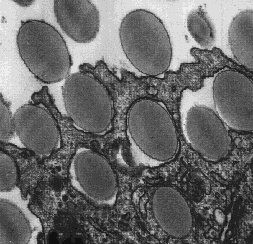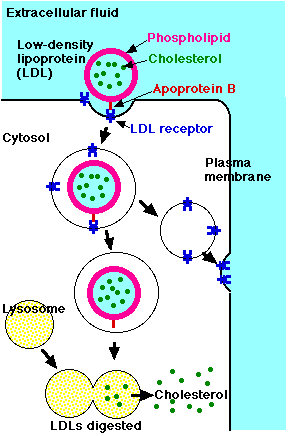In endocytosis, the cell ingulfs a drop of the extracellular fluid (ECF). It does this by folding inward a portion of its plasma membrane. The pouch that results is pinched off from the plasma membrane forming a membrane-enclosed bubble-like vesicle called an endosome.
 In phagocytosis ("cell eating"), the drop engulfed is relatively large (and the membrane-enclosed bubble is often called a phagosome or a vacuole).
In phagocytosis ("cell eating"), the drop engulfed is relatively large (and the membrane-enclosed bubble is often called a phagosome or a vacuole).
Phagocytosis:
This electron micrograph (courtesy of Dr. Robert J. North) shows a guinea phagocyte ingesting polystyrene beads. Several beads are already enclosed in phagosomes while the others are in the process of being engulfed.
In due course, phagosomes deliver their contents to lysosomes. The membranes of the two organelles fuse. Once inside the lysosome, the contents of the phagosome, e.g. ingested bacteria, are destroyed by the degradative enzymes of the lysosome.
| Games parasites play!
Phagocytic cells, like macrophages and neutrophils, are an early line of defense against invading bacteria. However, some bacteria have evolved mechanisms to avoid destruction even after they have been engulfed by phagocytes. Two examples:
|
Pinocytosis
A cell sipping away at the ECF by pinocytosis acquires a representative sample of the molecules and ions dissolved in the ECF. But endocytosis also provides a much more elegant method for cells to pick up critical components of the ECF that may be in scant supply.
Some of the integral membrane proteins that a cell displays at its surface are receptors for particular components of the ECF. For example, iron is transported in the blood complexed to a protein called transferrin. Cells have receptors for transferrin on their surface. When these receptors encounter a molecule of transferrin, they bind tightly to it. The complex of transferrin and its receptor is then engulfed by endocytosis. Ultimately, the iron is released into the cytosol. The strong affinity of the transferrin receptor for transferrin (its ligand) ensures that the cell will get all the iron it needs even if transferrin represents only a small fraction of the protein molecules present in the ECF. Receptor-mediated endocytosis is many thousand times more efficient that simple pinocytosis is enabling the cell to acquire the macromolecules it needs.
Cells take up cholesterol by receptor-mediated endocytosis. Cholesterol is an essential component of all cell membranes. Most cells can, as needed, either synthesize cholesterol or acquire it from the ECF. Human cells get much of their cholesterol from the liver and, if your diet is not strictly "100% cholesterol-free", by absorption from the intestine.
Cholesterol is a hydrophobic molecule and quite insoluble in water. Thus it cannot pass from the liver and/or the intestine to the cells simply dissolved in blood and ECF. Instead it is carried in tiny droplets of lipoprotein. The most abundant cholesterol carriers in humans are the low-density lipoproteins or LDLs.

LDL particles are spheres covered with a single layer of phospholipid molecules with their hydrophilic heads exposed to the watery fluid (e.g., blood) and their hydrophobic tails directed into the interior. Over a thousand molecules of cholesterol are bound to the hydrophobic interior of LDL particles. A protein, called apoprotein B is exposed at the surface of each LDL particle.
The first step in acquiring LDL particles is for them to bind to LDL receptors exposed at the cell surface. These transmembrane proteins have a site that recognizes and binds to the apoprotein B of the LDL. The portion of the plasma membrane with bound LDL is internalized by endocytosis. A drop in the pH (from ~7 to ~5) causes the LDL to separate from its receptor. The vesicle then pinches apart into two smaller vesicles: one containing free LDLs; the other containing now-empty receptors. The vesicle with the LDLs fuses with a lysosome to form a secondary lysosome. The enzymes of the lysosome then release free cholesterol into the cytosol. The vesicle with unoccupied receptors returns to and fuses with the plasma membrane, turning inside out as it does so. In this way the LDL receptors are returned to the cell surface for reuse.
People who inherit two defective (mutant) genes for the LDL receptor have receptors that function poorly or not at all. This creates excessively high levels of LDL in their blood and predisposes them to atherosclerosis and heart attacks. The ailment is called familial (because it is inherited) hypercholesterolemia.
Endocytosis removes portions of the plasma membrane and takes them inside the cell. To keep in balance, membrane must be returned to the plasma membrane. This occurs by exocytosis.
| Welcome&Next Search |